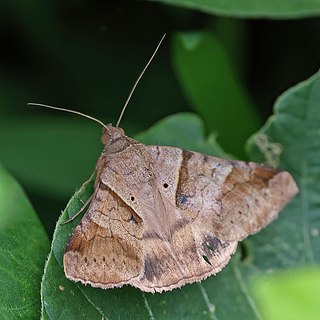
Mocis frugalis, the sugarcane looper, is a moth of the family Erebidae. The species was first described by Johan Christian Fabricius in 1775. It is found in several parts of the world, including India, Sri Lanka, West African countries and other Oriental regions. The adult is a fruit piercer and a major pest of crops.

Mocis undata, the brown-striped semilooper, is a moth of the family Erebidae. The species was first described by Johan Christian Fabricius in 1775. It is found in the Afrotropical and Oriental regions, including India and Sri Lanka.
Godasa is a monotypic moth genus of the family Noctuidae erected by Francis Walker in 1865. Its only species, Godasa sidae, was first described by Johan Christian Fabricius in 1794. It is found in Cameroon, the Democratic Republic of the Congo, Equatorial Guinea, the Gambia, Ghana, Guinea, Madagascar, Nigeria, Sierra Leone and Tanzania.

Mocis is a genus of moths in the family Erebidae. The genus was erected by Jacob Hübner in 1823.

Oraesia emarginata is a species of moth of the family Erebidae first described by Johan Christian Fabricius in 1794. It is found in Australia, New Caledonia, Indonesia, New Guinea, Pakistan, the Philippines, India, Sri Lanka, Sulawesi, Taiwan, China, Japan, Korea and Nepal as well as Eritrea, Ethiopia, Kenya, Namibia, Nigeria, South Africa, Tanzania, the Gambia, Uganda, Oman and Yemen.
Ancylolomia chrysographellus, the angled grass moth, is a species of moth in the family Crambidae. It is found on Cyprus and in Kenya, Uganda, Yemen, India, Pakistan, Sri Lanka, Myanmar, China, Korea, Japan, Taiwan, the Philippines and Indonesia.

Mocis mayeri is a species of moth in the family Erebidae first described by Jean Baptiste Boisduval in 1833. It has a wide range in Africa, which includes Cameroon, Cape Verde, the Comoros, the Democratic Republic of the Congo, Eritrea, Ghana, Kenya, Réunion, Madagascar, Malawi, Mauritius, Mozambique, Nigeria, Senegal, the Seychelles, Sierra Leone, South Africa, Sudan, Tanzania, the Gambia, Uganda, Zambia and Zimbabwe. It is also found in Saudi Arabia and Yemen.

Pycnarmon cribrata is a moth of the family Crambidae. It is known from Kenya, Zambia, Sierra Leone, South Africa, Malawi, Mozambique, the Democratic Republic of the Congo, Zambia and Zimbabwe.
Parotis marinata is a moth in the family Crambidae. It was described by Johan Christian Fabricius in 1784. It is found in India, Sri Lanka, New Guinea, on the Solomon Islands, the Democratic Republic of the Congo, South Africa. and Australia.





